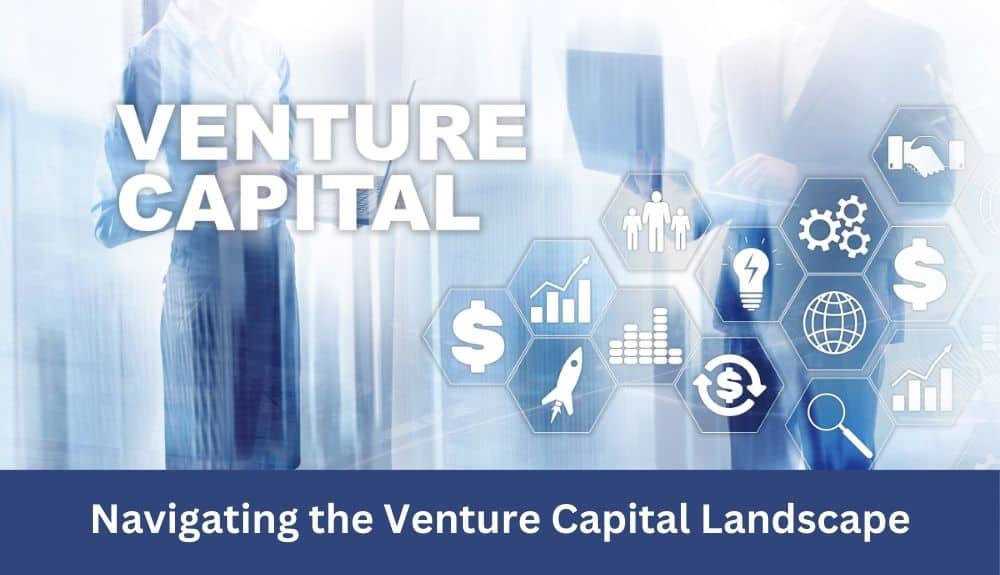In the fast-paced world of entrepreneurship, venture capital holds the key to turning dreams into reality. But what exactly do venture capitalists look for in a startup? How can entrepreneurs navigate the complex world of venture capital and secure the funding they need to propel their business forward?
Picture this: you have a groundbreaking idea, a promising business plan, and the drive to succeed. The missing piece of the puzzle? Venture capital funding. That’s where we come in.
In this article, we will delve into the inner workings of venture capital to demystify this enigmatic world. We will explore the expectations of venture capital investors, the intricacies of securing funding, and the crucial factors that can make or break a startup’s chances. With a deep dive into the startup ecosystem, we aim to equip entrepreneurs with the knowledge and insights necessary to navigate the venture capital landscape with confidence.
Join us on this journey of discovery as we unlock the secrets of venture capital and shed light on what it takes to secure the funding your business deserves. Don’t miss out on this opportunity to gain a competitive edge and position your startup for success.
Introduction to Venture Capital
Venture capital plays a critical role in fueling innovation, driving economic growth, and supporting the development of early-stage startups. As an alternative form of financing, it provides capital to innovative businesses with high growth potential that are often too risky for traditional lenders.
The primary purpose of venture capital is to bridge the funding gap experienced by early-stage companies, allowing them to grow and scale their operations. By providing financial resources, venture capitalists enable startups to invest in research and development, expand their teams, and enter new markets.
Venture capital also brings much more than just financial support. It offers strategic guidance, industry connections, and expertise through the involvement of experienced investors. These investors, often with a background in entrepreneurship themselves, bring valuable insights and mentorship to help startups navigate the challenges of building a successful business.
This form of financing is characterized by a high-risk, high-reward approach. Venture capitalists expect a significant return on their investment, with the potential for substantial profits through capital appreciation or successful exits, such as mergers, acquisitions, or initial public offerings (IPOs).
Overall, venture capital plays a pivotal role in fostering innovation, driving job creation, and advancing technological advancements. By providing the necessary funding and expertise, it fuels the growth of promising startups and contributes to the overall economic ecosystem.
Key Takeaways:
– Venture capital provides capital to early-stage startups with high growth potential.
– It bridges the funding gap and enables startups to invest in research and development, team expansion, and market entry.
– Venture capitalists offer strategic guidance, mentorship, and industry connections.
– Venture capital is characterized by a high-risk, high-reward approach, with the expectation of substantial returns.
– It contributes to the fostering of innovation, job creation, and technological advancements within the economy.
About the Ebook
In the world of venture capital, understanding the intricacies of how it works and how to successfully secure funding can be a challenge for entrepreneurs.
This comprehensive guide offers a step-by-step exploration of the venture capital landscape, providing valuable insights and practical advice for aspiring entrepreneurs. With a focus on demystifying the funding process and highlighting key strategies for success, this ebook serves as a valuable resource for those seeking to navigate the world of venture capital.
Whether you’re a first-time entrepreneur or looking to scale your existing business, “Demystifying Venture Capital” equips you with the knowledge and tools to understand the expectations of investors, refine your pitch, and secure the necessary funding to bring your vision to life.
This ebook is relevant to anyone interested in venture capital, from entrepreneurs and startup founders to professionals in the investment and finance industries. It offers invaluable insights into the workings of venture capital and demystifies the process of securing funding for your business.
Don’t miss out on this valuable resource—download “Demystifying Venture Capital: How It Works and How to Get It” today and gain a competitive edge in the world of entrepreneurship.
Key Definitions and Differences
When exploring the world of venture capital, it’s essential to understand the key terms and differences associated with this investment approach. Below, we define key terms and highlight the distinctions between venture capital and private equity.
1. Venture Capital:
Venture capital involves investing in early-stage companies with high growth potential. Venture capitalists (VCs) provide funding to startups in exchange for equity stakes, typically aiming for substantial returns on their investments. VCs often take an active role in mentoring and guiding the companies they invest in.
2. Private Equity:
Private equity involves investing in established companies to support their growth or facilitate restructuring. Unlike venture capital, private equity focuses on more mature businesses with a history of operations. Private equity firms acquire significant ownership stakes in companies and actively engage in their management.
3. Angel Investors:
Angel investors are high-net-worth individuals who provide capital to startups in the early stages. They often invest their own funds and play a crucial role in supporting entrepreneurs. Angel investors typically finance startups before they qualify for venture capital.
4. Limited Partners:
Limited partners are investors who commit capital to venture capital or private equity funds. They contribute financially but do not participate in the fund’s day-to-day operations. Limited partners include institutional investors, such as pension funds, endowments, and family offices.
5. Due Diligence:
Due diligence refers to the comprehensive assessment and analysis conducted by prospective investors before making an investment. It involves an examination of financial records, market potential, management capabilities, and legal considerations to evaluate the investment’s potential risks and returns.
6. Exit Strategy:
An exit strategy outlines how investors plan to liquidate their investment and realize their returns. Common exit strategies include initial public offerings (IPOs), acquisitions by larger companies, or management buyouts. Having a clear exit strategy is crucial for investors to generate profits.
Understanding these key definitions and differences is essential for entrepreneurs seeking venture capital funding or considering alternative forms of investment. By grasping the nuances of venture capital and its distinctions from private equity, aspiring entrepreneurs can navigate the investment landscape with clarity and confidence.
The Evolution of Venture Capital

Venture capital has come a long way since its inception, evolving into a distinct asset class that plays a pivotal role in funding early-stage startups. Understanding the historical development of venture capital is crucial to comprehending its significance in today’s entrepreneurial landscape.
The Birth of Venture Capital
The origins of venture capital can be traced back to the mid-20th century, primarily in the United States. In the aftermath of World War II, a wave of technological innovation swept across industries, creating opportunities for ambitious entrepreneurs. However, traditional sources of funding like banks were often hesitant to support these high-risk ventures.
It was during this time that a group of forward-thinking individuals recognized the potential of these startups and began providing financial backing. These individuals, known as venture capitalists, were willing to take on substantial risks in exchange for the potential of significant returns. They formed partnerships, pooling their resources to invest in these nascent companies.
From Niche to Mainstream
Throughout the 1960s and 1970s, venture capital grew in prominence and popularity. The development of Silicon Valley in California became a hotbed for technological innovation, attracting entrepreneurs and venture capitalists alike. This region became synonymous with groundbreaking startups and disruptive technologies.
As venture capital gained traction, new firms emerged, specializing in identifying and funding high-potential startups. The industry matured further, adopting structured investment approaches and specific evaluation criteria.
Professionalization and Global Expansion
The 1980s marked a crucial turning point for venture capital, as increasing institutionalization and professionalization brought further growth. Larger venture capital firms emerged, and a more systematic approach to investment decision-making took hold. This expansion paved the way for venture capital to reach beyond the confines of Silicon Valley and became a global phenomenon.
Throughout the decades that followed, venture capital continued to flourish, with various regions around the world developing their own vibrant startup ecosystems. Governments recognized the importance of venture capital in fostering economic growth and innovation, leading to the implementation of favorable policies and initiatives to support the industry.
Today and Beyond
Venture capital has established itself as a vital pillar of the entrepreneurial ecosystem, driving innovation and propelling promising startups towards success. The industry continues to adapt to changing trends and emerging technologies, investing in sectors ranging from biotechnology and clean energy to artificial intelligence and e-commerce.
As the venture capital landscape evolves, entrepreneurs must stay abreast of market trends and investor expectations to maximize their chances of securing funding. By understanding the historical context and growth of venture capital, aspiring entrepreneurs can navigate this dynamic field with confidence and position themselves for success in the ever-changing startup landscape.
Through its rich history and evolution, venture capital has become an integral part of the entrepreneurial journey, fueling innovation and driving economic growth.
The Importance of the Startup Ecosystem
The success of venture capital is intricately tied to the health and vibrancy of the startup ecosystem. A thriving startup ecosystem creates an environment that fosters innovation, entrepreneurship, and economic growth. Let’s explore the integral relationship between venture capital and the startup ecosystem, highlighting the factors that contribute to its success.
Nurturing Innovation and Entrepreneurship
Startups are the engines of innovation. They bring fresh ideas to the market and disrupt traditional industries. Venture capital plays a vital role in nurturing these startups, providing them with the necessary funding to turn their innovative ideas into reality. By injecting capital into early-stage ventures, venture capitalists enable entrepreneurs to develop and scale their businesses, creating new jobs and driving economic growth.
Access to Mentorship and Networks
Beyond capital, venture capital firms bring valuable expertise, mentorship, and networks to the table. Startups often face a myriad of challenges, ranging from product development to market expansion. Venture capitalists with experience in various industries can offer guidance and support, helping entrepreneurs navigate the complexities of the business world. Moreover, venture capital firms have extensive networks of industry contacts, facilitating valuable partnerships and collaborations for startups.
Risk Capital and Long-Term Investments
Startups require patient capital that is willing to embrace risk and support their long-term growth initiatives. Venture capital firms fill this crucial role by providing risk capital, accepting the inherent uncertainties of early-stage businesses. Unlike traditional lenders, venture capitalists understand that startups may face initial losses before reaching profitability. Their willingness to make long-term investments is vital to the survival and success of these early-stage ventures.
Fostering a Culture of Innovation
A robust startup ecosystem creates a culture of innovation and risk-taking. When entrepreneurs witness success stories within their community, it inspires them to pursue their own ventures. The presence of venture capital firms not only provides funding but also acts as a validation for aspiring entrepreneurs. Knowing that capital is readily available encourages more individuals to take the leap and transform their innovative ideas into viable businesses.
Facilitating Economic Growth
Investments made by venture capitalists have a ripple effect on the economy. Successful startups generate new employment opportunities, stimulate local economies, and contribute to overall economic growth. They attract talent and investment from around the world, establishing themselves as key players in their respective industries. The startup ecosystem supported by venture capital becomes a magnet for innovation and entrepreneurial activity, which in turn fuels economic development on a larger scale.
In conclusion, the startup ecosystem and venture capital are interdependent and mutually reinforcing. Venture capital fuels the growth of startups by providing necessary funding, expertise, and networks. On the other hand, a thriving startup ecosystem creates an environment conducive to innovation and entrepreneurial success. By recognizing and harnessing the power of the startup ecosystem, entrepreneurs can unlock the full potential of venture capital to launch their businesses to new heights.
The Indian Startup Ecosystem
The Indian startup ecosystem has experienced significant growth and diversification over the years, making it one of the most vibrant and dynamic in the world. Driven by a combination of factors such as a burgeoning entrepreneurial spirit, technological advancements, and favorable government initiatives, India has become a hotbed for startup innovation and investment.
Growth and Diversity
India’s startup ecosystem has witnessed remarkable growth in recent years, with the number of startups skyrocketing and attracting substantial investments. According to the National Association of Software and Service Companies (NASSCOM), India is home to over 50,000 startups, making it the third-largest startup ecosystem globally.
The growth of the Indian startup ecosystem can be attributed to several factors. Firstly, the country’s large and diverse consumer market serves as a fertile ground for startups to innovate and scale their businesses. With a population of over 1.3 billion people, India offers a vast customer base hungry for new products and services.
Furthermore, India’s increasing internet penetration and smartphone adoption have created a conducive environment for digital startups to thrive. Access to affordable smartphones and affordable data plans has unleashed the potential for various digital platforms, including e-commerce, fintech, healthtech, and edtech, to disrupt traditional industries and cater to the needs of the Indian population.
Key Drivers
Several key drivers have contributed to the growth of the Indian startup ecosystem. One of the crucial drivers has been the availability of venture capital funding. Venture capital firms, both domestic and international, have recognized the immense potential of Indian startups and have poured billions of dollars into the ecosystem. This influx of capital has provided startups with the necessary resources to scale their operations, develop innovative products, and attract top talent.
Another driving force behind the Indian startup ecosystem is the strong support from the Indian government. The government has introduced initiatives such as the “Startup India” campaign, which aims to create a favorable environment for startups by offering tax benefits, relaxed regulations, and access to funding. Additionally, the “Digital India” campaign has played a significant role in boosting digital infrastructure development, enabling startups to leverage technology and reach a broader audience.
Government Initiatives
The Indian government has taken proactive measures to foster innovation and entrepreneurship within the country. Apart from the aforementioned initiatives, the government has established incubators, accelerators, and startup hubs across various cities to nurture and support early-stage startups. These initiatives provide startups with mentorship, networking opportunities, and access to a vibrant community of like-minded entrepreneurs.
Additionally, the government has launched schemes like the “Stand-up India” program, which aims to facilitate loans and support for women entrepreneurs and individuals from marginalized backgrounds. Such initiatives promote inclusivity and diversity within the startup ecosystem, paving the way for a more vibrant entrepreneurial landscape.
In conclusion, the Indian startup ecosystem has evolved into a thriving and diverse ecosystem, driven by factors such as a large consumer market, access to capital, and supportive government initiatives. With continuous innovation, visionary entrepreneurs, and a conducive environment, India is poised to cement its position as a global player in the startup arena.
Access to Capital and Funding
Access to capital is a pivotal factor for startups looking to transform their innovative ideas into successful businesses. While traditional financing methods may not always be suitable for early-stage ventures, angel investors and venture capital funding offer viable alternatives. In this section, we will explore the role of angel investors and venture capital in supporting startups and provide insights into the funding process.
Angel Investors: A Ray of Hope
Angel investors play a crucial role in providing initial funding to startups. These wealthy individuals, often entrepreneurs themselves, are willing to invest their personal capital in promising early-stage companies. With their experience and expertise, angel investors bring not only financial support but also valuable guidance and mentorship to the table.
Startups seeking angel investment typically go through a rigorous screening process. Angel investors carefully evaluate key aspects of the business, such as the market potential, management team, unique value proposition, and growth trajectory. Demonstrating a compelling business model, solid market research, and a potential for high returns is crucial to attracting angel investments.
Venture Capital: Fueling Growth and Scalability
Venture capital (VC) takes the funding game to the next level. VC firms, consisting of professional investors, pool together funds from various sources, like high-net-worth individuals, institutional investors, and pension funds, to fuel the growth of startups. In exchange for their investments, VC firms acquire an equity stake in these companies.
Securing venture capital goes beyond the initial financial investment. Investors also provide strategic guidance, industry connections, and operational support to help startups scale and succeed. However, attracting venture capital requires a strong value proposition, a compelling business model, and a team that demonstrates exceptional potential.
The Funding Process: A Balancing Act
The funding process can seem complex, but understanding the key steps involved can provide entrepreneurs with a roadmap for success. The process typically includes the following stages:
1. Identification: Entrepreneurs identify potential angel investors or VC firms that align with their industry and investment requirements.
2. Pitching: Entrepreneurs prepare a comprehensive business plan and pitch to capture investors’ attention. A well-crafted pitch emphasizes the startup’s unique selling proposition, market opportunity, growth potential, and financial projections.
3. Due Diligence: Investors conduct thorough due diligence to assess the viability of the startup. This includes analyzing financial statements, market research, competitive landscape, and the team’s capabilities.
4. Term Sheet: If the due diligence comes out positively, the investor presents a term sheet outlining the key terms and conditions of the proposed investment, including the valuation and equity stake.
5. Closing the Deal: Upon mutual agreement, the investor and entrepreneur proceed to the final stage, where legal documentation and contracts are finalized, and funds are disbursed.
Entrepreneurs should approach the funding process with meticulous preparation, concise communication, and a clear understanding of their business goals. Establishing trust, highlighting growth potential, and showcasing a solid team are essential to securing investment.
Conclusion
Access to capital is a critical enabler for startups to propel their growth and achieve their visions. Angel investors and venture capital funding provide avenues for entrepreneurs to access crucial resources, guidance, and financial support. By effectively navigating the funding process and aligning their business strategies, entrepreneurs can unlock the doors to success and turn their startup dreams into reality.
Sectors Contributing to the Startup Story
The startup ecosystem has experienced significant growth and dynamism over the years, with key sectors playing a pivotal role in driving innovation and attracting venture capital investments. Let’s delve into some of these sectors that have contributed to the success story of startups.
Enterprise Tech: Transforming Industries Through Innovation
Enterprise technology has revolutionized various industries by providing cutting-edge solutions and optimizing business processes. From cloud computing and cybersecurity to data analytics and artificial intelligence, startups in the enterprise tech sector have been instrumental in driving digital transformation. These startups offer scalable and efficient solutions that enable businesses to streamline operations, improve productivity, and gain a competitive edge.
Ecommerce: Unlocking New Market Opportunities
The rise of ecommerce has transformed the way businesses operate and consumers shop. Startups in the ecommerce sector have disrupted traditional retail models, offering consumers convenient and personalized shopping experiences. With the advent of online marketplaces, mobile payments, and logistics solutions, ecommerce startups have opened up new market opportunities and empowered small businesses to reach a global customer base.
Healthcare: Revolutionizing Patient Care and Treatment
The healthcare sector has witnessed a tremendous influx of startups focused on improving patient care, diagnosis, and treatment outcomes. These startups leverage technology to develop innovative solutions in telemedicine, digital health, wearable devices, and personalized medicine. By harnessing the power of data analytics and artificial intelligence, healthcare startups aim to enhance medical decision-making, optimize patient monitoring, and improve overall healthcare delivery.
Educational Tech: Reshaping the Future of Learning
With the evolution of technology, the educational sector has also witnessed disruption and innovation. Educational tech startups are leveraging digital platforms and tools to transform the way people learn and acquire knowledge. From online learning platforms and interactive educational content to gamified learning experiences and virtual classrooms, these startups are reshaping the future of education and making learning more accessible and engaging for all.
These key sectors represent just a glimpse of the vast and diverse landscape of the startup ecosystem. Each sector brings its own unique set of challenges and opportunities for entrepreneurs and investors alike. By understanding the trends and dynamics within these sectors, entrepreneurs can identify market gaps and develop disruptive ideas that have the potential to attract venture capital funding.
Understanding Investor Expectations
When seeking venture capital funding, it’s crucial for entrepreneurs to understand the criteria and expectations that investors have when evaluating investment opportunities. By aligning their efforts with these expectations, entrepreneurs can increase their chances of securing funding. Here are some key factors that venture capital investors consider:
Team:
Venture capital investors place great emphasis on the team behind a startup. They look for founders who not only have relevant industry experience but also possess strong leadership skills and a clear vision for the company’s future. Investors want to see a cohesive team that can execute the business plan effectively and adapt to challenges along the way.
Market Potential:
Investors are constantly seeking startups that operate in high-growth markets with significant potential for disruption. They analyze the size of the target market, market trends, and the startup’s unique value proposition. Startups that can demonstrate a deep understanding of their target market and possess a scalable business model have an advantage when it comes to attracting venture capital investment.
Scalability:
Venture capital investors are looking for startups with the potential for rapid growth and scalability. They want to invest in companies that can achieve significant returns on their investment within a relatively short period. Startups that can demonstrate a clear path to scaling their operations, acquiring customers, and generating revenue are more likely to attract venture capital interest.
Traction and Milestones:
Investors seek evidence of progress and traction in a startup’s journey. They want to see tangible results, such as user acquisition, revenue growth, and successful product launches. Startups that have achieved significant milestones and demonstrated market validation are better positioned to secure venture capital funding.
Unique Value Proposition:
Venture capital investors look for startups that offer a unique and differentiated product or service. They want to invest in companies that have a competitive edge over existing solutions in the market. Startups must be able to clearly articulate their unique value proposition and why customers would choose their offering over competitors.
Exit Strategy:
Investors are also interested in understanding the potential exit opportunities for their investment. They want to ensure that there is a clear and viable path for the startup to generate returns for shareholders. Common exit strategies include acquisition by a larger company or an initial public offering (IPO).
By addressing these expectations, entrepreneurs can better position themselves to attract venture capital investment. It’s essential to thoroughly research potential investors and tailor pitches to align with their investment criteria. Building relationships with investors and leveraging their expertise can also significantly increase the chances of securing funding.
Remember, venture capital investors are not just looking for innovative ideas; they are also seeking startups with a compelling team, a scalable business model, and a clear path to success. By understanding and addressing these expectations, entrepreneurs can increase their chances of successfully navigating the venture capital landscape and securing the funding they need to fuel their startup’s growth.
Navigating the Venture Capital Landscape

Entering the world of venture capital can be a daunting task for entrepreneurs, but with the right strategies and knowledge, securing funding for your startup becomes more achievable. As you embark on this journey, here are some essential tips to navigate the venture capital landscape effectively:
Building Relationships with Investors
Building strong relationships with venture capital investors is crucial for entrepreneurs seeking funding. Establishing connections within the industry can provide valuable insights, guidance, and access to potential funding opportunities. Here’s what you need to keep in mind:
1. Research and Identify Suitable Investors: Conduct thorough research to identify venture capital firms or individual investors that align with your industry, stage of growth, and business model. Look for investors who have a track record of funding startups similar to yours.
2. Attend Networking Events and Conferences: Participate in relevant networking events, conferences, and pitch competitions to meet potential investors face-to-face. These platforms offer opportunities to showcase your startup, gain exposure, and build connections.
3. Leverage Warm Introductions: Utilize your network to seek warm introductions to investors. Recommendations from trusted individuals can significantly increase your chances of capturing an investor’s attention and securing a meeting.
4. Engage in Thought Leadership: Establish yourself as a thought leader in your industry by actively participating in relevant communities, contributing to industry publications, or speaking at conferences. This helps build credibility and increases your chances of attracting investor interest.
5. Maintain Strong Relationships: Once you establish connections with investors, nurture those relationships by providing regular updates on your progress, seeking their advice and feedback, and demonstrating your commitment to long-term success.
Crafting a Compelling Pitch
The pitch is your opportunity to impress investors and showcase the potential of your startup. To create a compelling pitch, keep the following pointers in mind:
1. Clearly Articulate Your Value Proposition: Explain how your product or service solves a problem or addresses a market need. Clearly communicate the unique value your startup brings to the table and its potential for growth.
2. Highlight Your Market Potential: Investors want to see opportunities for significant returns. Present your market research, demonstrating the size, growth rate, and competitive landscape of your target market.
3. Showcase Your Team’s Expertise: Emphasize the capabilities and experience of your team. Investors look for entrepreneurs who not only have a solid understanding of their industry but also possess the necessary leadership and execution skills to drive the business forward.
4. Present a Scalable Business Model: Clearly outline your revenue model and growth projections. Investors want to see that your startup has the potential to scale and generate substantial returns on their investment.
5. Be Prepared for Due Diligence: Anticipate the questions investors may ask and be prepared to provide detailed information about your business, including financials, market validation, competitive analysis, and intellectual property.
Remember, the venture capital landscape is highly competitive, and securing funding can be a challenging process. However, by building strong relationships with investors and crafting a compelling pitch that clearly demonstrates the potential of your startup, you increase your chances of attracting the right investors and securing the funding needed to propel your business forward.
Conclusion
In conclusion, venture capital plays a critical role in funding early-stage startups and driving innovation. Through this article, we have demystified the world of venture capital, providing entrepreneurs with valuable insights into how it works and what investors expect.
Key takeaways from this article include the importance of understanding the criteria and expectations that venture capital investors have when evaluating investment opportunities. Factors such as the team’s expertise, market potential, and scalability are crucial considerations for investors.
Navigating the venture capital landscape can be a challenging endeavor, but by building strong relationships with investors and preparing a compelling pitch, entrepreneurs can improve their chances of securing funding. It is essential for entrepreneurs to recognize the integral relationship between venture capital and the startup ecosystem, leveraging the resources and support available to them.
Aspiring entrepreneurs must grasp the significance of venture capital in fueling the growth and success of their ventures. By understanding the inner workings of venture capital and aligning their strategies and goals accordingly, entrepreneurs can increase their chances of securing funding and achieving their entrepreneurial aspirations.
Remember, venture capital is not just about funding; it is about accessing a vast network of resources, expertise, and guidance that can accelerate the growth and success of startups. So, embrace venture capital as a powerful tool and use it to unlock the potential of your entrepreneurial journey.






